This post may contain affiliate links.
How to Avoid Crashes & What Is Defensive Driving – A Definition
What is defensive driving? And how to avoid crashes? Defensive driving is using actionable driving strategies to eliminate or minimize risk – and help avoid crashes – by actively anticipating hazards on the road.
What Is Defensive Driving – Active Vs Passive Drivers
Defensive driving is about being active, not passive. It’s about preventing collisions way before they even have a remote chance of happening.
If you’re a passive driver, you just drive down the road, minding your own business. You don’t think about the other drivers, and road users around you too much. When things happen, the passive driver then reacts.

If you’re a more active driver, you drive down the road, but you don’t just mind your own business. You mind other people’s business. And this is a good thing. To be a defensive driver is to defend; to defend your safety. I know, we hear a lot nowadays to mind our own business. And to not judge. Well, I am telling you for driving, ignore all of that.
For defensive driving, we must mind people’s business.
- Judge cars
- Judge space
- Judge distance
- Judge speed
- Judge the driver’s mental state
- I mean, someone who has just stolen a car and robbed a bank with it probably doesn’t care about stop sign rules too much. Just guessing.
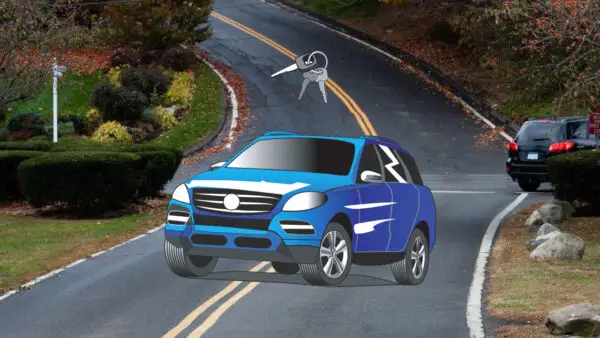
Active, defensive drivers are thinking about the other road users and drivers around them. But what exactly about them?
It’s about anticipating the movements and patterns of others before things happen. This way, when things happen, the active driver is never surprised & always prepared. The active driver prevents crashes before they ever had a chance.
Drivers are somewhat predictable. For example:
If a driver is in a merging lane on the highway, they are probably merging, even if they forgot their turn signal. It’s not like it’s going to surprise you that they want to merge into your lane, right? Their car is not going to evaporate. It’s going to merge. Facts.

Most people don’t like waiting behind another vehicle that has stopped to turn left. Most drivers don’t like waiting behind a bus that has pulled over to let off passengers. You can get almost psychic here. It’s easy to predict – at least sometimes – where cars are going to go. Sometimes, you’ll know where they’re going before they do.
- If a lane is closed up ahead due to construction, most drivers will be lane-changing to get around it.
The passive driver simply waits for exciting things to happen, and then tries to see if they can get out of situations. Usually, it’s too late. Crashes happen quickly. The only way to prevent them is to drive defensively and stop all possibilities of a crash. Unfortunately, we can’t press pause while we are driving.
Keep Your Distance
One of the most important defensive driving techniques you can do is to keep a safe following distance.

You’ve probably heard of the 2 or 3-second rule, and you probably know to increase it at highway speeds or during poor visibility and conditions. This space is crucial and gives you the gift of time. Time to deal with things. It also gives you better visibility.
It’s hard to see up ahead if you are staring at the tail lights of the vehicle in front of you because you are too close. Just remember that there is no such thing as too much space. You can have a huge chunk of space between you and the vehicle in front of you and still be going at the same speed. Driving with the proper amount of space in front of your vehicle is one of the most crucial defensive driving habits you can have.
Timing
Sorry to sound obvious, but cars are moving things. Each driver decides how fast to drive. At any given moment, there’s a perceived appropriate speed, for any particular driver to be driving.
But have you ever wondered how many people could have avoided a collision if they had been in the same spot even 1-2 seconds earlier, or later? This 1-2 second difference is not about luck, it’s about intentional timing.
Crashes with 2 or more vehicles happen when 2 or more vehicles try to enter the same space at the same time. So, in order to be a defensive drivers, and prevent crashes, we need to become experts in space management and timing.

Eyes & Eye Contact for Defensive Driving
What you do – or don’t do – with your eyes, is so important. It’s such a critical skill to be able to look as far ahead as you can see while keeping your eyes moving. If you look far ahead, you can see issues that are coming up. You have more time to position yourself in a good place, and can plan a turn or lane change if needed.
If you simply stare at the pavement in front of your front bumper, like sadly a lot of drivers do, you’ll be forced to be a reactive, uninformed driver, prone to many surprises. Car won’t go in a straight line? Read this.
Look At Drivers, Not Just Cars
A lot of new drivers don’t automatically think to look at drivers, so much as at cars. It’s an essential defensive driving habit to look for eye contact from other drivers and road users. If a driver is looking right at you, it’s unlikely a crash will occur. Cars are inanimate objects. Drivers make cars come alive.
This is simply because of the general idea that in the vast majority of crashes, people don’t tend to hit things that they can see.
In other words, people crash into stuff that they didn’t know was there. Or maybe they couldn’t see and took a chance. It’s the same thing. As drivers, we can’t talk to each other. So we have to stare at each other instead.

So, to be a safe, defensive driver and avoid crashes, you need to make sure that other drivers can see you; or at least know that you exist. To know you exist, they either have to see you (preferably) or hear you.
Look for eye contact whenever possible. Purposefully position your vehicle at a certain, strategic spot – in relation to the vehicles around you – at all times. And since cars are always moving, drivers need to check their mirrors frequently so they have an accurate picture of what’s going on at all times.
And, purposefully and carefully time all of your movements. Take into consideration all road users around you, and their current and potential planned movements.
We really can’t afford to just stare at the scenery, or daydream, or not think about driving, while driving. We really need to treat driving as the passive active, focused, mental sport that it is. Never stay in another vehicle’s blind spot.
What Is Defensive Driving – Look For Eye Contact
Don’t just look at the car. Look at the driver. If the driver is looking at you, well, that’s good. It means they’re doing their job at that particular moment.
If you don’t have eye contact at a time when you think you should, you can cover your horn. This means just getting ready to honk quickly.
This isn’t to get mad; this is simply to let the other driver know “hey, there’s someone here other than you.” Trust me when I say they would rather hear your horn than crash into you if those were their only two options.
Let Other Road Users Know You Exist
Don’t be afraid to tap your horn and let the driver know that you exist. That is just much better than having a crash. The other driver doesn’t want to crash, and they might even thank you. No one wants to have a crash, but humans do get distracted. Or, they are simply looking the wrong way for a variety of reasons.
The following driver – we can see – is facing a yield sign. So, they should yield. If it looks like they aren’t looking, and/or are not planning to yield, my first plan of attack should be to honk.
New drivers tend to want to slam on the brakes during times like this, but what if there’s a semi-truck behind you? Why bother being rear-ended by a semi-truck (or any vehicle) when you can simply honk, and ask the other driver to yield as they’re supposed to.
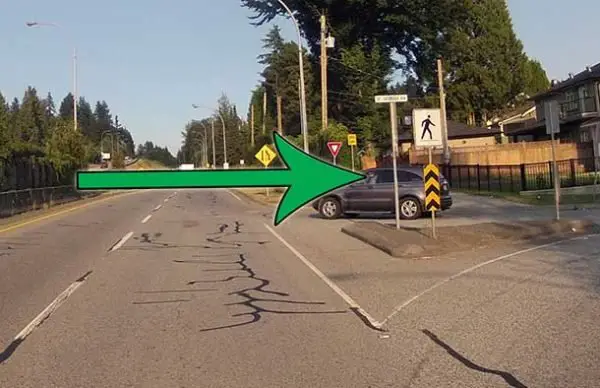
Avoid Driving In a ‘Pack’
It seems to be a real thing. Cars, like wolves, travel in packs. It just seems to happen that way. Maybe because of red lights and stuff like that.
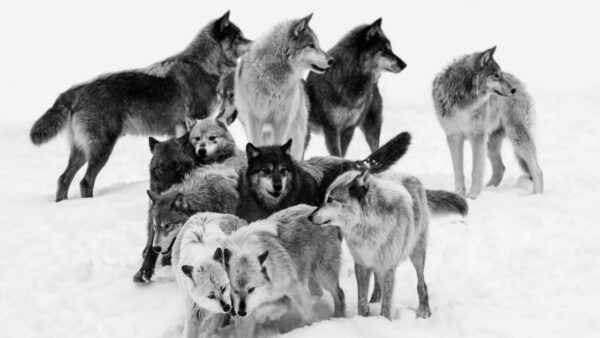
But, as part of your defensive driving habits, you don’t have to travel in a pack. And, it’s relatively easy to separate yourself from the pack.
Then, you’ll be driving “alone”. And it’s kind of hard to have a collision with another vehicle if there are none anywhere around you. Even during rush hour, there are options for avoiding the packing problem.
Keep Track Of Surroundings At All Times
Another defensive driving tip is to keep track of everything. If you don’t know what’s around you, then you can’t do anything useful about it. The way to do this is of course to keep your eyes moving, including mirror checking.
This may sound like a lot of work, but it’s just a habit you can practice, and it gets easier.
- Is there a space beside you right now?
- Where’s the space, on your left or right?
- Is there a motorcycle beside you in your blind spot?
- Where are the cars?
- Where are the chunks of space?
- Keep track of this all the time
Keeping An Escape Route
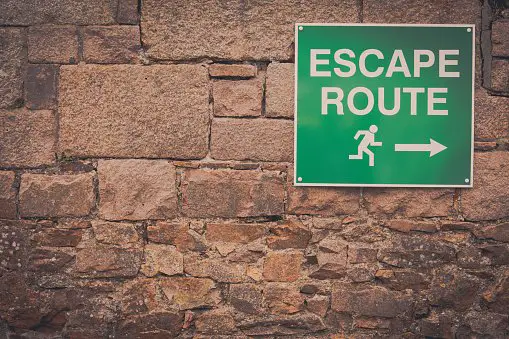
Escape route. Not escape room. Defensive driving and strategic drivers will always keep an escape route at all times. In the following photo, the black truck has no escape route, except maybe in front.
Try to avoid situations like this where you are stuck between vehicles and have no extra space anywhere. If something happens, this truck has nowhere to escape.
This driver could so easily give themselves an escape route if they simply eased off their accelerator, and drove with space – not cars – beside them. It’s true that we can not control other drivers. So, it’s not always easy to control the spaces beside and behind you.
However, the chunk of space in front of us is one area that we can control the easiest; the one we perhaps have the most control over. If a vehicle is following way too close behind you, you can be a defensive driver and leave additional space in front of you.
That way, if you need to stop, you can be sure to slow down gradually – not abruptly – and will be able to avoid a rear-end collision if the person behind isn’t paying attention.
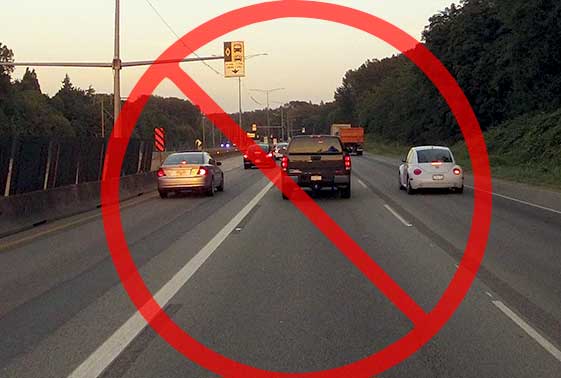

I’m not saying to never have a car beside you; of course there will be one. But just try to time things when you’re driving along, whenever possible, to keep space in front and beside you.
Always Assume That Drivers Want to Lane Change
It’s what cars do
Expect drivers to lane change, regardless of whether or not their car is displaying a turn signal. Let’s think about this for a minute.
If someone turns right, and then turns right, and then turns right, and then turns right (or turn left and then left and then left and then left) they would be driving in a circle – or should I say a square – all day.

Most people don’t want to do that because most people drive their car in order to get somewhere, not to drive in circles. I know, this is so very profound.
This means drivers will – for example – turn right and then most likely want to do a lane change sooner or later, to turn left. For your defensive driving habits, you should expect this and leave room for it.
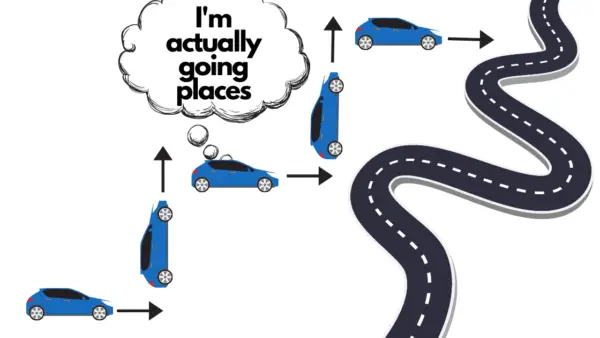
Notice the movements of these vehicles
Cars in the left lane want the right lane. Cars in the right lane want the left lane. This is normal, and it’s not just because the grass is greener on the other side… or is it? This is especially common near entrances to freeways and other exciting ramps, destinations, or properties.
When the Light Goes Green, Hesitate for 2-3 Seconds
Yet another life-saving defensive driving tip is to wait several seconds after the light goes green. If there’s a vehicle in front of you, this will automatically help to get your following distance in front. You always want to make sure to scan intersections before proceeding, especially if you’re the first one.
Remember you can have a large space in front of you AND go the same speed as traffic. And, it will time it so you’re not in the blind spot or right beside other vehicles.
What Is Defensive Driving – Strategic Turning
When turning, stagger it so when you’re turning there is a space beside you, not a car.
Think About Other Drivers’ Blind Spots
Blind spots. You know where they are, right? When going through the blind spots, try to pass through that area quickly and don’t stay in someone’s blind spot; especially when passing through the blind spots of large trucks. Stay in front, or behind it. So simple.
What is defensive driving: Here is an example of staggered vehicles
I know, we don’t often have the luxury of driving on a road with so few vehicles. But look at this beautiful staggering effect. The thing is, it’s basically impossible for any of these vehicles to crash into one another right now, right?

- Each car can see the other cars in his/her/their mirrors
- No one is in anyone’s blind spot
- If someone wants to do a lane change it will be very easy because everyone has at least a 2-second following distance
- Everyone has their escape route – some extra space on the side they could use if need be
- Try to drive like this whenever possible
Be Predictable – Do What You Say You’re Going To Do
If you’re in a left-turning lane, then turn left. If you have a right turn signal on, then turn right. Part of defensive driving is being predictable. Do not change your mind at the last second. Think of everything from the other driver’s point of view.
Just as you are anticipating others, they are anticipating you. This includes expecting you to do something you say you were going to. Where do the people around you think you’re going to go? You should probably go there. Use signals early; as early as possible without confusing the other road users.
Be Patient
In life, we must share the roads… Unless you own your own road; in which case, can I be your friend? Remember that all types of people are driving on the road. This includes drivers of varying experience and age levels.
How to Avoid Crashes & What Is Defensive Driving – Conclusion
Hopefully, you have a better understanding of defensive driving techniques. Humans are notoriously impatient, and imperfect. Just keep this in mind. Get rid of the idea that other drivers will drive properly all the time. It’s just not going to happen. If you have low standards, then you won’t tend to be disappointed or surprised.
If another driver makes a mistake, don’t take it personally. If you don’t know them, then you have no idea what’s going on in their life. I just find it helps to have low expectations and to be very patient. Remember there is never a rush. Take your time, relax, and be safe. Driving is supposed to be fun.
Pro Tip: Grab some mini blind spot mirrors or a convex rear-view mirror from Amazon or somewhere else. These can literally be your extra eyes, and help you to see so much more.

A woman was driving across the white lines in a parking lot not bothering to use the lane that was…